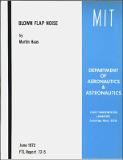Blown flap noise
Author(s)
Haas Martin
DownloadFTL_R_1972_05.pdf (4.017Mb)
Other Contributors
Massachusetts Institute of Technology. Flight Transportation Laboratory
Metadata
Show full item recordAbstract
This report is concerned with the noise generated by blown flaps of the type currently being developed for the short take off and landing aircraft. The majority of the report is an experimental study of the sound-radiation produced by a small scale externally blown double-slotted flap model. Tests were carried out with and without a forward velocity of 60 MPH for a basic engine-wing configuration and for a modified (Engine moved inboard) configuration. Noise radiation patterns and sound pressure level spectra were obtained for nozzle exhaust velocities between 100 and 500 ft/sec. In addition all model data was extrapolated to five fictional full scale STOL aircrafts. The noise generated by the impingement of the jet on the externally blown flap is highly dependent on the jet velocity and the flap position. As the flap angle is increased the noise generated increases. At the 45* - 70* flap position the noise is more than 25db over that caused by the model jet alone. It is especially louder below the wing. The sound power level generated by the externally blown flap (at all positions) increased with the sixth power of the jet's blowing velocity. As the nozzle jet velocity is increased, the sound power level of the noise from the nozzle alone generally increased with the expected eighth power of the jet velocity. Therefore, the difference between the impingement noise and the noise of the nozzle alone decreased with increasing velocity. The noise radiation pattern becomes more directed below the wing as the flaps are lowered. The effect of forward velocity on the noise generated was neglible for a ratio of jet to forward velocity greater than 4.5. Results on tests made on the modified engine-wing configurations were similar to that of the basic configuration except for a slight reduction in overall sound pressure level (2 to 4 db) over all positions measured. An extrapolation to full scale indicated that the externally blown flap noise must be suppressed to meet STOL aircraft noise goals.
Description
June 1972 Also issued as an M.S. thesis, Massachusetts Institute of Technology, Dept. of Aeronautics and Astronautics, 1972 Includes bibliographical references (p. 91)
Date issued
1972Publisher
Cambridge, Mass. : Massachusetts Institute of Technology, Flight Transportation Laboratory, [1972]
Other identifiers
13493219
Series/Report no.
FTL report (Massachusetts Institute of Technology. Flight Transportation Laboratory) ; R72-5
Keywords
Flaps (Airplanes), Short take-off and landing aircraft, Aerodynamic noise